Day 1 of a three day long weekend of tours today. We met in Wells and made our way east, turning off the coast road and continuing our way along a little inland.
We pulled up at the start of a quiet, overgrown country lane and got out of the car. Immediately, we could hear a great variety of bird song on all sides of us. A Song Thrush was singing from deep in the trees, and a Chaffinch from above our heads. A Chiffchaff was doing a passable rendition of its name. We could hear the lovely, fluid notes of a Blackcap too. A little further along, and we picked up the high-pitched song of a Goldcrest. A Cetti’s Warbler shouted at us from the bushes as we passed.
A shape perched up in the dead branches of a tree beside the road was a cracking male Bullfinch, bright pinkish-red below with a smart black cap. He stayed there for several seconds while we admired him, but before the scope was on him he flew off calling, with a second Bullfinch calling nearby.
We stood for a while where the hedges are at their most overgrown. A pair of Common Whitethroats were busy flicking in and out of the bushes. More Blackcaps were singing from the trees and we could see a female, with brown cap, in one of the willows. A Great Spotted Woodpecker called from the poplars and a Treecreeper appeared, climbing up one of the larger tree trunks.
Our hope was to hear a Nightingale singing here. We did get one very brief phrase, but then it went quiet, before everyone could hear it. It was a bit cool first thing this morning, cloudy, with a rather blustery wind coming through the trees – not hot and sunny, like a Nightingale might prefer. We could hear a Cuckoo singing further up the road, so we decided to walk up there to look for that instead, and come back later to see if the Nightingale had woken up properly.
As we got to the gate which overlooks the meadows beyond the wood, we saw the Cuckoo fly across into the willows beyond. We just had time to get it in the scope, before it flew again and this time we could see that there were two Cuckoos, a pair. They chased each other in and out of the trees for some time, back and forth across the meadow in front of us. Occasionally perching up where we could see them. At one point, the female landed in a low tree out across the meadow right in front of us. The male Cuckoo wasn’t singing much, and the female was silent, but we were treated to great views of them.
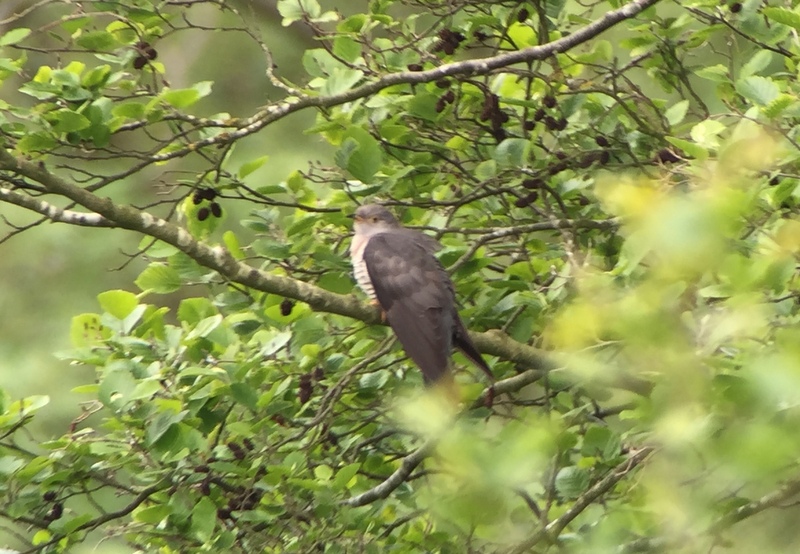 Cuckoo – the female perched in a low tree in front of us
Cuckoo – the female perched in a low tree in front of us
Eventually, the two Cuckoos disappeared back into the trees and we decided to make our way back. We stopped again where we had heard the Nightingale briefly earlier, but all seemed quiet. Then suddenly it started singing right behind us! It was still not in full song but gave us a couple of bursts, to let us know where it was hiding. We could hear that it was moving away along the hedge, then suddenly it flicked up out of the bushes and darted across the road, fanning its rusty orange tail and flashing it at us as it dived into the hedge the other side.
After a minute of two, the Nightingale started singing again further up. We followed the sound and stood listening to it, such a magical song, before it darted back across the road again. It worked its way back along the hedge past us, deep in cover, singing on and off as it went. Then we decided to leave it in peace.
As we walked back towards the car, we could hear a delicate tacking call, more of a tutting, ‘tsk, tsk’, coming from a hawthorn bush beside the road. It was a Lesser Whitethroat, the call notably softer than a Blackcap, but it was hiding deep on the other side of the hedge from us. We stood patiently for a minute or so and gradually it worked its way up higher, to where we could see it. Almost back to the car, and a Red Kite drifted leisurely up the valley past us.
The forecast had suggested it would brighten up quickly this morning, but that wasn’t the case and it had remained stubbornly cool and cloudy so far. We decided we would head on up to the Heath anyway. As we walked up along the path, we could hear Willow Warblers singing. A Woodlark flew overhead, looking strikingly short-tailed. As we crossed the road, a Garden Warbler was singing from deep in the trees.
We made our way down to where one of the pairs of Dartford Warblers have been. A couple of days ago they were feeding newly fledged youngsters here, so the likelihood is that they shouldn’t have gone far. But we couldn’t find them today in any of the likely spots.
There were lots of other birds to see here. A Woodlark flew across and disturbed a male Stonechat from the top of a dead tree, before dropping down into the grass. We walked over to see if we could find it again, but the vegetation was a bit tall. There was a pair of Stonechats perched on the tops of some low gorse bushes and a streaky juvenile Stonechat appeared with them. The Stonechat we had seen knocked off its perch was nearby, a second male, a paler interloper. When it flew back up to the top of the dead tree, it joined a smart male Yellowhammer up there now, with a lovely bright yellow head. Lots of Linnets were twittering from the gorse, including some increasingly bright red-breasted males.
 Linnet – there are lots on the Heath, including several smart red males
Linnet – there are lots on the Heath, including several smart red males
We walked round some other likely areas, listening for the calls of the young Dartford Warblers. We couldn’t hear them anywhere, but we did hear a most unexpected sound. A Nightjar started churring, in the middle of the day! The Heath is a good place for Nightjars, but they generally don’t make a sound until dusk.
Round in a new clearing, a couple of Mistle Thrushes were feeding amongst the fallen branches and grass, before a passing walker flushed them and they flew into the top of a low pine tree. We could hear Willow Warblers all over the Heath and eventually we found one singing from the top of a birch tree. We got it in the scope, noting the long wings, pale legs and well-marked, lemon-yellow washed supercilium, all good features to help distinguish Willow Warbler from the very similar Chiffchaff.
 Willow Warbler – singing from the top of a birch tree
Willow Warbler – singing from the top of a birch tree
The family of Dartford Warblers were nowhere to be found, so we decided to move on and try to find another pair. The next ones we tried have been much harder to see in recent days but as we stood quietly in one of their favoured areas, the male Dartford Warbler hopped up onto a low gorse bush in front of us. As we watched him flitting between the gorse and heather, the duller female appeared with him. We got them in the scope and had a great look at them.
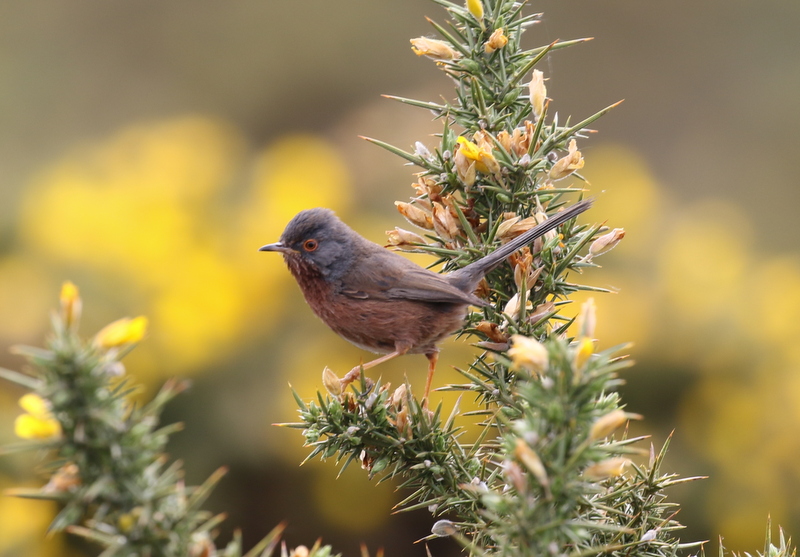 Dartford Warbler – this photo of one taken previously here
Dartford Warbler – this photo of one taken previously here
After watching the Dartford Warblers for some time, enjoying some great prolonged views, we eventually tore ourselves away and headed back to the car for lunch. While we ate, a Turtle Dove flew over the car park and disappeared off towards the trees. A Sparrowhawk circled up above us, gaining height before flying off over the ridge, bursts of rapid flapping interspersed with glides in typical Sparrowhawk fashion.
Our next stop was at Felbrigg Park, where we walked down through the trees towards the lake. We stopped to scan the flooded grazing meadow on the way. A couple of Egyptian Geese were asleep in the grass, with a pair of Greylags and a pair of Canada Geese nearby too. A Lapwing was feeding on the edge of the shallow water. There was no sign of the Garganey here at this point, but it has been on the lake more often recently so we figured it must be there.
More excitement here was provided by a battle between a male Pheasant and a pair of Moorhens. The Pheasant was clearly feeling confident, having just seen off a rival, when the Moorhens attacked, presumably having a nest nearby, raising their winds to make themselves look as big as possible. One of the Moorhens lunged repeatedly at it, flapping its wings and striking it with its feet. Eventually the Pheasant saw sense and retreated.
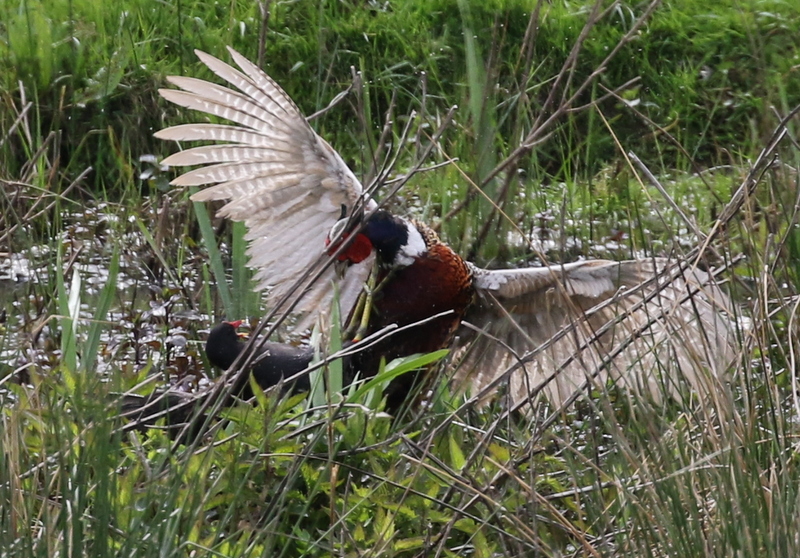 Pheasant vs Moorhens – the Moorhens won!
Pheasant vs Moorhens – the Moorhens won!
As we continued along the path a small bird flew out of a hawthorn bush in front of us and across the path. As it flew in front of us, we could see a bright orange tail – it was a stunning male Redstart! It darted into a clump of gorse the other side and we could just see it perched for a couple of seconds – white forehead, black face and bright orange underneath – before it dropped down out of view. Redstarts used to breed at Felbrigg but have not done so for several years and these days they are just very occasional visitors, so this was a particularly nice surprise.
We made our way down to the lake and the first thing we noticed was a drake Mandarin. Rather than being out on the water it had chosen a particularly odd place to go to sleep, on a rather thin bare branch hanging out across the water. There were a few other ducks here too – a pair each of Tufted Ducks and Gadwall, and several Mallard and their domesticated cousins. But there was no sign of the Garganey on here either.
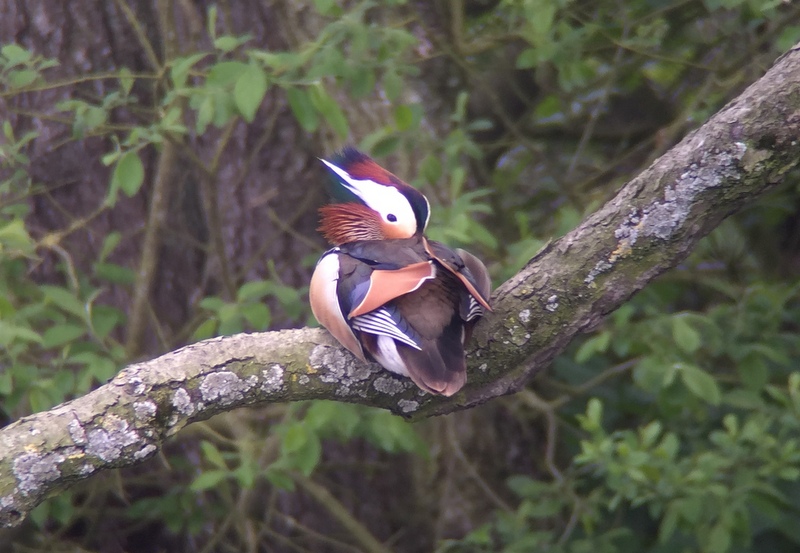 Mandarin Duck – sleeping on a rather narrow branch out over the water
Mandarin Duck – sleeping on a rather narrow branch out over the water
A couple of Reed Warblers were singing from the reeds and a male Reed Bunting perched up on the top of a bulrush. Along the edge of the reeds, we could see a Sedge Warbler clambering around just above the water’s surface.
As we walked across the grass beside the lake, a Mistle Thrush dropped down in front of us, where a recently fledged juvenile Mistle Thrush was waiting for it. The youngster was presented with a rather large worm, which it didn’t seem interested in. The trees round the other side were rather quiet, apart from a Nuthatch piping away from deep in the wood, so we walked back round towards the water meadow.
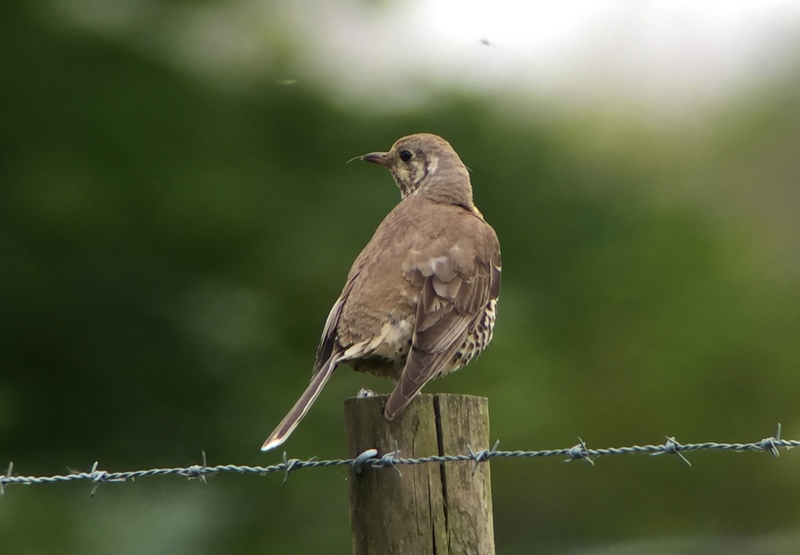 Mistle Thrush – a pair were feeding a recently fledged juvenile in the grass
Mistle Thrush – a pair were feeding a recently fledged juvenile in the grass
Back there, we bumped into a local birder who told us that he had just seen the Garganey. After some careful searching, and with his help, we finally located it hiding in the vegetation. It was feeding, pulling at the plants in the water, but all we could see at first was its head appearing occasionally out of the greenery, a lovely rich reddish brown with a striking white stripe across it, a cracking drake.
Then the Garganey did the decent thing and swam out into full view. They are stunning little ducks, beautifully patterned. It started calling, a funny croaking rattle, and bobbing its head up and down. When it swam over to the other side, one of the local Coots started chasing it. Initially it climbed out onto the bank and sat down for a few seconds. When it tried to go back into the water the Coot was after it again and eventually it decided it had had enough and flew off towards the lake.
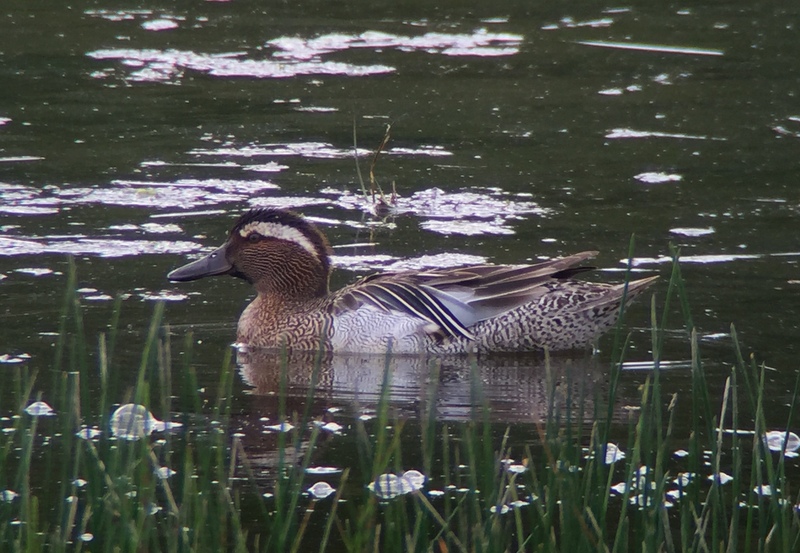 Garganey – the stunning drake at Felbrigg still
Garganey – the stunning drake at Felbrigg still
We made our way back to the car and headed back down towards the coast. We didn’t have much time left, but had a look at a few spots along the way. A Hobby powered out of some trees and circled up beside the road. We managed to follow it, slowly in the car, and suddenly it started twisting and turning. When we pulled up we could see it was chasing a Swift. A second Hobby appeared with it and the two of them chased the Swift away and out of view.
As we passed the duck pond at Salthouse, we could see a few Tufted Ducks but one of them was noticeably duller, with grey-brown stained flanks rather than the pure white of a normal male. On closer inspection, it had a chestnut tone to its dark breast and a dark chestnut face and crown contrasting with a green-glossed back of its head. The crest was also not long enough for a Tufted Duck.
 Tufted Duck x Ferruginous Duck hybrid – has been hanging around for several days
Tufted Duck x Ferruginous Duck hybrid – has been hanging around for several days
This bird has been around here for a couple of days now and appears to be a Tufted Duck x Ferruginous Duck hybrid. Who knows where it might have come from, but the 2013 storm surge here on the coast set free several captive ducks from the collection at Blakeney, so perhaps we are now seeing the results of that. There have been several odd ducks along the coast here in recent weeks.
There are always lots of people feeding the ducks at Salthouse and lots of food remains lying around on the ground at the end of the day. The local Brown Rats have obviously learnt to take advantage of the free food too!
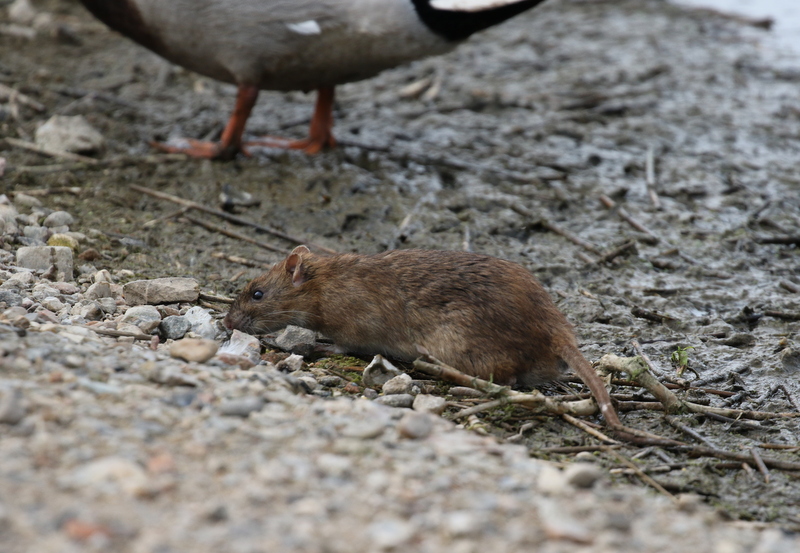 Brown Rat – eating the leftover food at the duck pond
Brown Rat – eating the leftover food at the duck pond
A quick scan of the Serpentine and Pope’s Marsh didn’t reveal anything of note, although a Little Grebe was on Snipe’s Marsh the other side of the road. Then unfortunately it was time for us to head back to Wells.
















